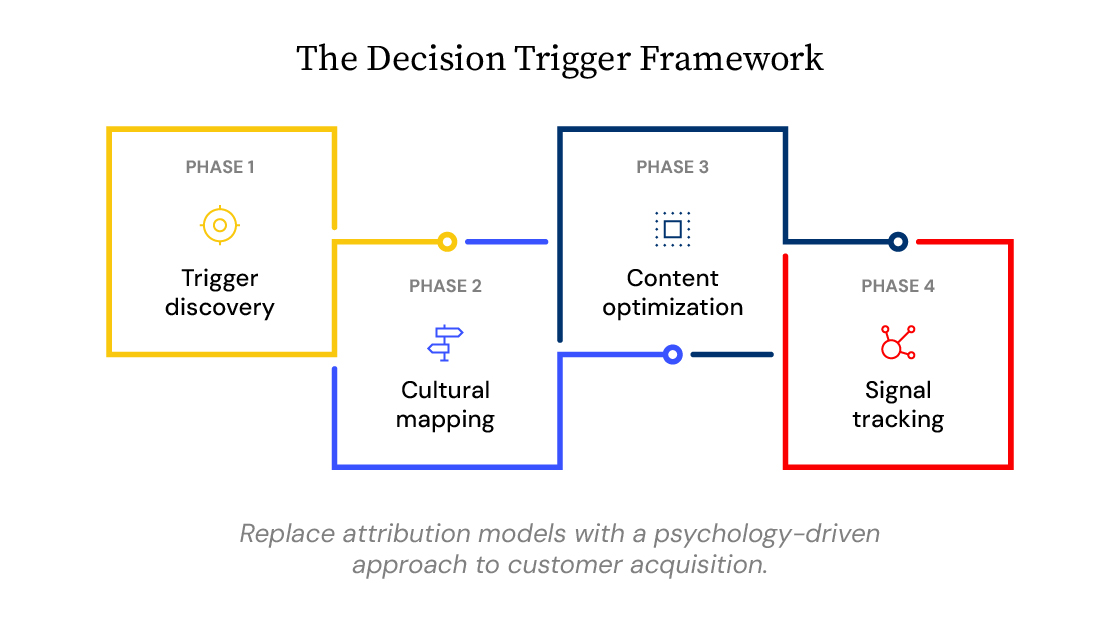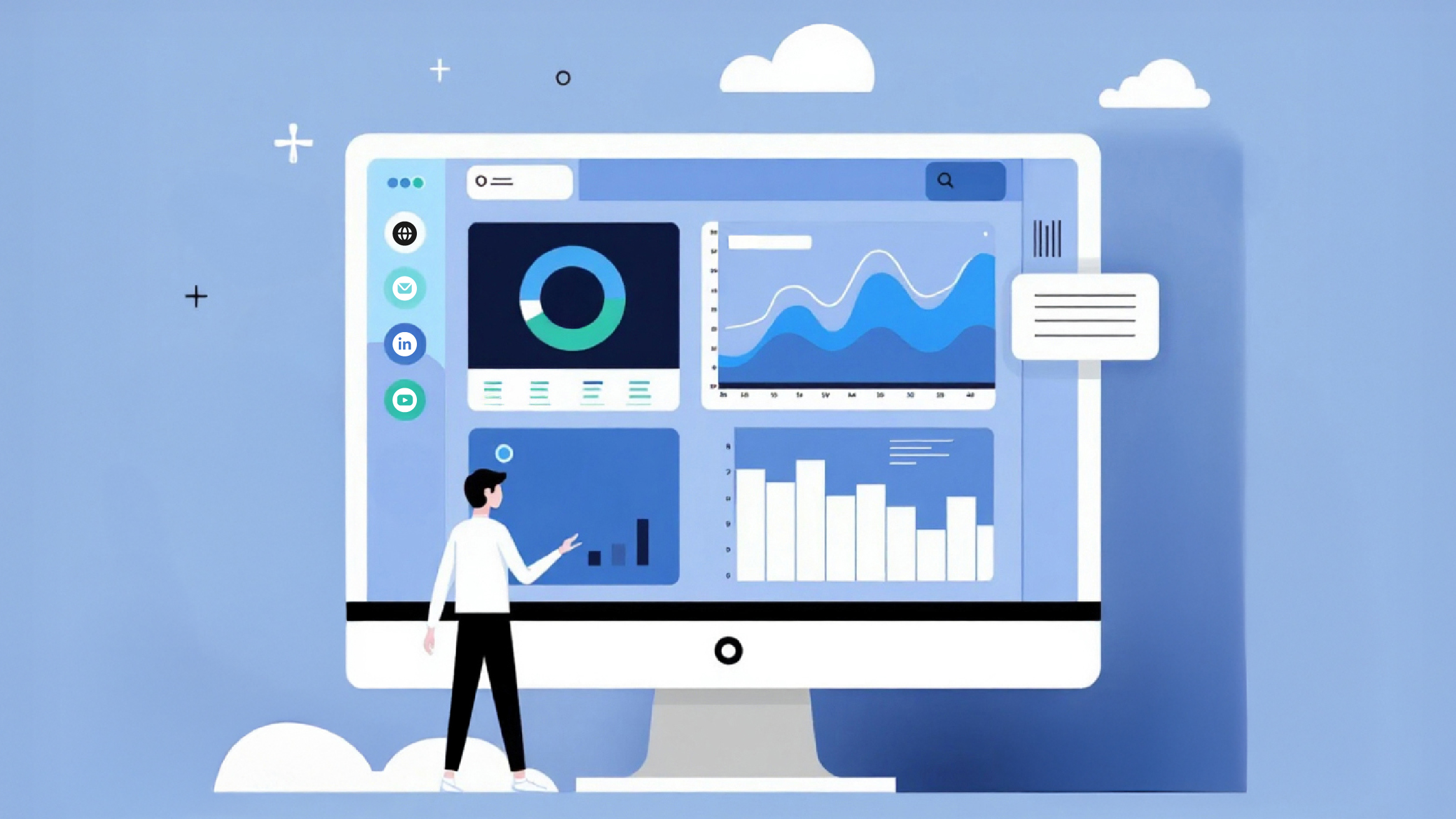Summary
The industry's obsession with tracking every touchpoint is obscuring the decision triggers that actually drive buying behavior and undermining true marketing ROI.
The $180,000 measurement problem
A marketing team spends six months implementing a multi-touch attribution model, tracking 47 touchpoints across 12 platforms. Beautiful dashboards show precisely how prospects clicked, viewed, and downloaded before converting.
The CMO presents confidently: “We have complete visibility. LinkedIn generates 23% pipeline influence, content marketing contributes 31%, webinars add 19% attribution value.”
Three months later, customer acquisition still feels random. Sales teams are frustrated because their hottest leads aren’t coming from the “highest attributed” channels. Despite sophisticated analytics, marketing ROI remains unclear.
This is the attribution illusion—measurement systems that obscure rather than illuminate customer behavior.
What attribution models actually measure
Attribution models excel at measuring activity, not influence. They document the digital exhaust of prospects who were already planning to buy, but they’re remarkably poor at identifying what actually caused the buying decision.
Consider a multi-experience development platform we worked with. Attribution models showed prospects engaging with 8-12 touchpoints before converting, allocating credit across webinars, whitepapers, and ads with mathematical precision.
But customer interviews revealed something different: 91% could identify a single moment when they shifted from “exploring options” to “we need to evaluate this company.” For many, it was reading a specific case study or gaining a particular insight during a webinar Q&A.
The attribution model gave equal credit to the decisive case study and the seventh ad impression. This is like crediting both the match and the firewood equally for starting a fire.
The regional complexity problem
Attribution assumptions work poorly across different business cultures. What triggers decisions in Silicon Valley doesn’t translate to consensus-driven German enterprises or relationship-first Asian markets.
Working with a franchise network across Eastern India, we discovered that South Indian attribution models produced 67% higher costs and 40% lower performance in Eastern markets. The same business model required completely different decision triggers based on regional psychology:
Bihar/Jharkhand regions: Timeline urgency (“Make this reality before Chhath Puja”)
West Bengal: Regional pride (“Lead Bengal’s education renaissance”)
Northeast states: Leadership recognition (“Pioneer education in your community”)
Same investment, same returns—entirely different psychological triggers based on cultural decision patterns.
The decision trigger alternative
Instead of tracking touchpoint sequences, focus on decision triggers—specific psychological moments when prospects shift from passive exploration to active evaluation.
A sustainable mobility platform connecting automotive corporates, startups, and investors taught us this lesson. Rather than building attribution models, we spent three weeks in structured conversations:
Innovation managers: “I get 47 startup pitches weekly. I have four hours for partnership evaluation. This platform isn’t another touchpoint—it’s a filter that gives me back 40 hours monthly.” (Trigger: Workflow efficiency)
Startup founders: “Getting to decision-makers is a 6-month nightmare. This isn’t about nurturing—it’s about access to authority.” (Trigger: Access to power)
Industry experts: “I don’t know how to package 30 years of expertise commercially. This isn’t content distribution—it’s professional validation.” (Trigger: Recognition value)
Understanding these triggers enabled 22 qualified leads from €2,600 spend—demonstrating superior results through trigger-focused customer acquisition.

A more intelligent framework
Phase 1: Trigger discovery
Replace demographic research with psychological moment identification: “What specific insight shifted this from ‘someday’ to ‘this quarter’ priority?”
Phase 2: Cultural trigger mapping
Different business cultures have different decision psychology requiring tailored approaches.
Phase 3: Content trigger optimization
Create content designed to activate decision moments rather than nurture through arbitrary funnel stages
Phase 4: Behavioral signal intelligence
Track behaviors that correlate with decision triggers:
- Time spent with trigger-specific content
- Decision velocity from trigger exposure to qualification
- Cross-stakeholder trigger validation patterns
Why this works
Humans don’t make complex decisions through gradual information accumulation. We make them in moments—specific instances when our mental model shifts from “interesting possibility” to “viable solution.”
Enterprise purchases involve multiple stakeholders with different triggers, timelines, and decision criteria. Attribution models treat buying committees like individual consumers, missing the interpersonal dynamics that drive enterprise decisions.
The moment someone becomes genuinely interested often happens offline—in conversations, through insights, or via experiences that leave zero digital footprints. Your attribution model credits the retargeting ad, but it was actually the conference hallway conversation.
The strategic reality
Companies focusing on decision triggers instead of attribution optimization gain three advantages: improved efficiency (resources focus on trigger content), better sales alignment (teams understand what motivated leads), and competitive differentiation (while competitors optimize models, trigger-focused companies create genuinely persuasive experiences).
This shift requires operational changes: abandoning attribution dashboards, embracing customer conversation discipline, and accepting measurement complexity that’s more accurate than precise attribution.
The bottom line
Attribution models create measurement theater while obscuring customer psychology. Decision trigger intelligence requires genuine curiosity about what actually motivates buying decisions—less quantifiable but infinitely more valuable.
Your customers aren’t optimizing through touchpoint sequences. They’re making complex decisions based on psychological triggers, cultural contexts, and emotional responses that attribution models miss entirely.
Understanding why people buy matters more than counting how many times they clicked.
Key Takeaways
Focusing on psychological decision triggers rather than multi-touch attribution models delivers more accurate insights and significantly improves marketing ROI. By tailoring triggers to cultural contexts and optimizing content around them, businesses boost efficiency, align sales and marketing, and gain a competitive edge.






